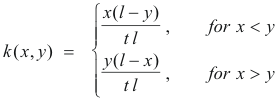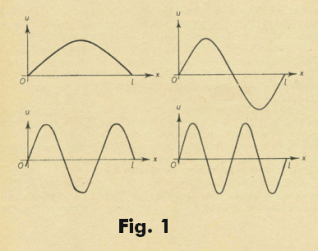Website owner: James Miller
Integral equations. Kernel. Eigenvectors and eigenvalues. Self-adjoint linear operators.
Def. Integral equation. An equation in which the unknown function occurs under an integral sign. Examples of integral equations are Fredholm’s integral equations of the first, second and third kinds:
1. Fredholm’s integral equation of the first kind. The equation
![]()
in which g and K are two given functions and f is the unknown function.
2. Fredholm’s integral equation of the second kind. The equation
![]()
in which h and K are two given functions and f is the unknown function.
3. Fredholm’s integral equation of the third kind. The equation
![]()
in which g, h and K are given functions and f is the unknown function.
Kernel of an integral equation. The function K(x, y) in the above equations is called the kernel of the equation. If K(x, y) = K(y, x) the kernel is said to be symmetric.
Of special interest is Fredholm’s integral equation of the second kind. Many problems in physics lead to this equation. One place where it arises is in the study of small oscillations of elastic systems.
This equation has two forms, inhomogeneous and homogeneous:
Inhomogeneous form
![]()
Homogeneous form
![]()
The inhomogeneous form corresponds to 2) above and the homogeneous form is obtained from the inhomogeneous form by letting h(x) = 0.
The homogeneous equation always has the zero solution, i.e. the solution y(x) = 0.
In operator notation the inhomogeneous integral equation 4) above can be written as
f = λAf + h
and the homogeneous equation as
f = λAf
where A denotes the operator.
Theorem 1. If Fredholm’s homogeneous integral equation has only the zero solution, then the corresponding inhomogeneous equation is soluble for every function f(x).
Eigenvectors and eigenvalues. Given: a linear operator A on a vector space V. An eigenvector is a nonzero vector v ε V that is imaged by A into a vector λv, a scalar multiple of itself. That is, it is a vector v ε V such that Av = λv where λ is a scalar called an eigenvalue. An eigenvector of a linear operator A corresponds to any of those vectors in the domain which are imaged by A into scalar multiples of themselves.
Eigenvalues and eigenvectors are highly importance in applications. They arise in many areas of mathematics, physics, chemistry and engineering. They arise in analytic geometry in connection with finding that particular coordinate system in which a conic in the plane or a quadric surface in three-dimensional space finds its simplest canonical expression. In physics and engineering they arise in connection with finding, for example, the critical frequencies of a vibrating string, suspension bridge or rotating shaft, the critical load of a supporting column or the energy levels of a system in quantum mechanics.
For the case when the vector space V is n-space and the operator A is an n-square matrix, the eigenvalues are given as the roots of the characteristic equation of matrix A and the eigenvectors are vectors in n-space that A images into scalar multiples of themselves. For the case when A is an integral operator and V is Hilbert space, eigenvectors correspond to those vectors (functions) of Hilbert space that A images into scalar multiples of themselves. In this case the eigenvectors are called eigenfunctions. For example, the homogeneous integral equation
![]()
can be written as Af = λf and the solution f(x) of the equation corresponds to those functions that A carries into scalar multiples of themselves.
Many problems in physics lead to homogeneous integral equations in which the kernels are symmetric as a consequence of the law of conservation of energy. The eigenfunctions and eigenvalues of equations with symmetric kernels have a number of important properties. For example:
Theorem 2. A homogeneous integral equation with a symmetric kernel always has a sequence of real eigenvalues
λ1 , λ2, ...... , λn , ......
To every eigenvalue there correspond one or more eigenfunctions. The eigenfunctions corresponding to distinct eigenvalues are always orthogonal to each other.
Example. The problem of finding the characteristic frequencies of a vibrating string of length l, tension t, and density (mass per unit length) ρ, fastened at both ends, leads to the homogeneous integral equation with a symmetric kernel
![]()
where

and ω represents frequency.
This equation has the solution u(x)
![]() 0 for every value of ω, which corresponds to the state of
rest. The values of ω for which other solutions exist are called the eigenfrequencies of the
system.
0 for every value of ω, which corresponds to the state of
rest. The values of ω for which other solutions exist are called the eigenfrequencies of the
system.
The system can perform free oscillations only at definite frequencies. The smallest of these is called the fundamental tone of the system and the others are overtones.
Solution of the above equation yields an infinite sequence of eigenfrequencies, the so-called frequency spectrum
ω1 , ω2, ...... , ωn , ......
The nonzero solution un(x) corresponding to the frequency ωn represents the form of the corresponding characteristic oscillation.
The characteristic frequencies are
![]()
where


The fundamental tone is ω1 = a(π/l) and the overtones are ω2 = 2ω1, ω3 = 3ω1, ..... , ωn = nω1. The form of the corresponding harmonic oscillations is given by the equation
![]()
and illustrated in Fig. 1 for n = 1, 2, 3, 4, ....
Self-adjoint linear operators. For an arbitrary linear operator in a Hilbert space the analogue of the symmetric kernel of the integral equation is the property of self-adjointness of the operator. The condition for an operator to be self-adjoint is that for any two elements f1 and f2 of the space the equation
(A f1, f2) = ( f1, Af2)
holds, where (A f1, f2) denotes the inner product of A f1 and f2.
Theorem 3. An integral operator with a symmetric kernel is self-adjoint.
Arbitrary self-adjoint operators have a number of important properties that are useful in applications.
Theorem 4. The eigenvalues of a self-adjoint linear operator are always real and the eigenfunctions corresponding to distinct eigenvalues are orthogonal to each other.
We note the similarity between Theorems 2 and 4.
References
James & James. Mathematics Dictionary
Mathematics, Its Content, Methods and Meaning. Vol. 3, Chap. XIX
Jesus Christ and His Teachings
Way of enlightenment, wisdom, and understanding
America, a corrupt, depraved, shameless country
On integrity and the lack of it
The test of a person's Christianity is what he is
Ninety five percent of the problems that most people have come from personal foolishness
Liberalism, socialism and the modern welfare state
The desire to harm, a motivation for conduct
On Self-sufficient Country Living, Homesteading
Topically Arranged Proverbs, Precepts, Quotations. Common Sayings. Poor Richard's Almanac.
Theory on the Formation of Character
People are like radio tuners --- they pick out and listen to one wavelength and ignore the rest
Cause of Character Traits --- According to Aristotle
We are what we eat --- living under the discipline of a diet
Avoiding problems and trouble in life
Role of habit in formation of character
Personal attributes of the true Christian
What determines a person's character?
Love of God and love of virtue are closely united
Intellectual disparities among people and the power in good habits
Tools of Satan. Tactics and Tricks used by the Devil.
The Natural Way -- The Unnatural Way
Wisdom, Reason and Virtue are closely related
Knowledge is one thing, wisdom is another
My views on Christianity in America
The most important thing in life is understanding
We are all examples --- for good or for bad
Television --- spiritual poison
The Prime Mover that decides "What We Are"
Where do our outlooks, attitudes and values come from?
Sin is serious business. The punishment for it is real. Hell is real.
Self-imposed discipline and regimentation
Achieving happiness in life --- a matter of the right strategies
Self-control, self-restraint, self-discipline basic to so much in life